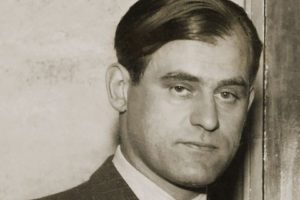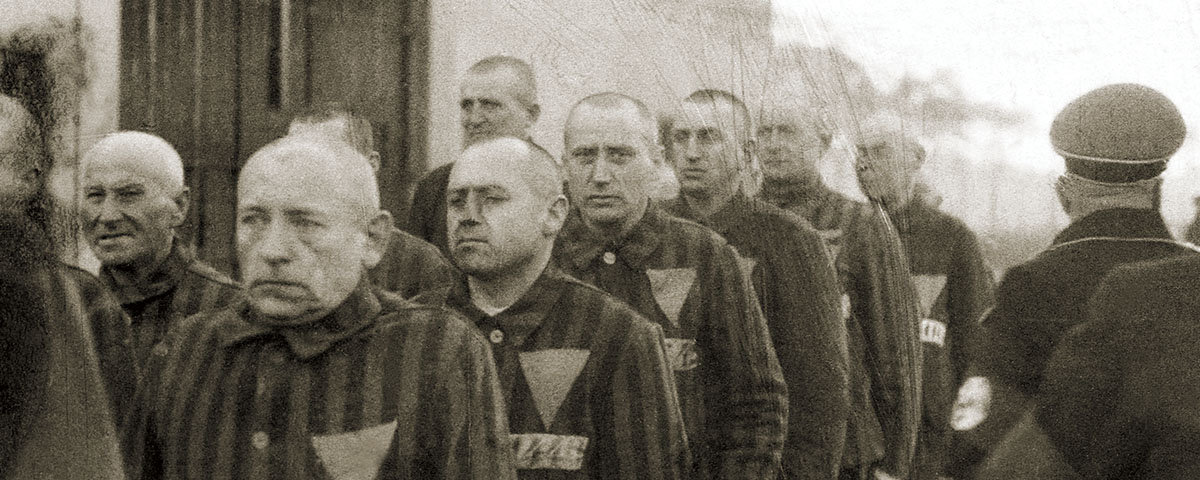“I must unburden my memory,” Odd Nansen wrote in the diary he secretly kept during his three and a half years in Nazi concentration camps, all the while wondering whether anyone would believe what he described.
ON JANUARY 13, 1942, ODD NANSEN, A 30-YEAR-OLD NORWEGIAN ARCHITECT AND HUMANITARIAN, was arrested by the Gestapo for his high-profile role in the country’s nascent anti-Nazi resistance movement. Nansen, the founder of the humanitarian organization Nansenhjelpen (Nansen Relief), which aided Jewish refugees fleeing Nazi persecution, was clearly following in the footsteps of his father, Fridtjof, an Arctic explorer and humanitarian who was awarded the Nobel Peace Prize in 1922 for his work on behalf of World War I refugees. (That year Fridtjof also created the “Nansen passport”—the first legal travel document for refugees.)

Odd Nansen spent the next three and a half years in Nazi concentration camps: Grini in Oslo, Veidal above the Arctic Circle, and Sachsenhausen in Germany. Through it all he kept a secret diary, recording the mundane and horrific details of his existence and describing the casual brutality and random terror that was the way of life—and death—in the camps. Little by little, Nansen managed to smuggle out the tissue-paper-thin pages of his diary, sometimes inside hollowed-out breadboards.
Following his liberation from Sachsenhausen in 1945, Nansen helped to found UNICEF. His diary was a bestseller when it appeared in book form in Norway, and it was widely praised following its publication in the United States, under the title From Day to Day, in 1949. (Nansen donated the proceeds of the German edition of his book to German refugee relief work.) But soon the book fell into obscurity. In 1956 Carl Sandburg singled it out as an undeservedly neglected work, calling it “an epic narrative [that] takes its place among the great affirmations of the power of the human spirit to rise above terror, torture, and death.”
After the war Nansen resumed his career as an architect while continuing to speak out against injustice, oppression, and violence. He died in 1973.
WEDNESDAY, OCTOBER 6, 1943
We were in the cattle cars [en route to Sachsenhausen], tired and stiff after a night and a day without sleep or rest. The platform and the road outside, which crossed the railway line here, was swarming with children, little boys of four or five. They had all got themselves wooden tommy guns, just like those the SS guards had. With these they took aim at us and blazed away. For we were enemies! They knew that much. The little boys ran after us along the road with their tommy guns and had a big afternoon.
SUNDAY, OCTOBER 10, 1943
On every hand we see fellow creatures slipping downward. Poles, Russians, Germans, Belgians, Frenchmen, Ukrainians, Dutchmen, Rumanians, Czechs, Hungarians. Their faces grin on one in a sneer of hate, derision, and agony. Piles of corpses! Corpses alive and dead! And an appalling stench that threatens to suffocate one. Wherever one turns, always the same nightmare, the same appalling vision.
Oh, if one could only wake up from this nightmare, wake and find that there exists another reality…
MONDAY, OCTOBER 11, 1943
This is a hell for Russian prisoners. About fifteen thousand of them have marched through the gate from time to time, and there are only eight or nine hundred left in the camp. The rest have been starved to death, beaten to death, or otherwise done away with…. Hangings take place on the parade ground, and everyone has to look on.
From the great annihilation camps in Poland—Auschwitz, Lublin, and others—where hundreds of thousands upon hundreds of thousands of Jews were being killed, there came incessantly to Sachsenhausen railway trains full of the clothing, footwear, and effects of the murdered Jews. A special squad of many hundreds of prisoners were employed exclusively in ripping open these clothes and shoes, out at one of the factories to which the prisoners were “hired” from the camp. Sewn into the clothing they discovered fortunes in banknotes—and in the footwear, especially in the high heels of the women’s shoes, they found little treasures of jewels. Each day’s “catch” was several tubs full of jewels and ornaments and great bundles of banknotes. One has to go back to one’s childhood’s fairy book, the Thousand and One Nights, for a counterpart to all that shining splendor. The rightful owners have been put to eternal silence in the gas chambers of Poland, and no one can prevent the SS and the big “factory owners,” Himmler, Göring, and Goebbels from taking over the goods.
Inside the barracks, or “blocks” as they are also called, water is never used at all for cleaning; the beds and bedclothes are never washed. Early and late we have this roaring and display about peinliche Sauberkeit [scrupulous cleanliness], and outside and between the barracks are gardens of flowers and little railings along all the paths, of fir branches with the bark on. It looks well-kept and idyllic, and a “visitor” never gets a glimpse of the fact that it only serves as a frame for the most unbounded filth, the worst hatching ground for lice and bacteria.
TUESDAY, OCTOBER 12, 1943
We live on cabbage soup and potatoes, potatoes and cabbage soup. Both for dinner and for supper we have cabbage soup. It does happen that we have spinach soup and potatoes, that is, it happened once, and no doubt that was cabbage soup too, only the cabbage was green. For breakfast we get another kind of soup with bread crumbs in it—or so-called coffee—with the bread ration, which is small, but of good coarse bread. Butter we get a dab of twice a week. When we have coffee we get something with it, a bit of sausage, some cheesy substance, or jam. All ersatz of course; it has a sinister look, but we are hungry.
At night, when I lie thinking and thinking, I seem to see the gas chambers where thousands upon thousands of Jews, Poles, and others have been killed. The prussic-acid chambers in Lublin camouflaged as bathhouses, which the poor souls enter thinking they’re to have a bath. There are men in this camp who come from Lublin, and can describe these things because they have seen them. They’re not fantasy. Nor is it a fantasy that in this camp they have cars so constructed that the exhaust flows into the car, which is hermetically sealed. A ten-minute drive in such a car is enough to send anyone to eternity. The cars have been in frequent use. Hundreds of victims have been carried out of them and “gone up the chimney.” And there are still several deaths a day, though it’s no longer so ghastly as it was—nothing like! There have been times here, when a normal order in the barracks every morning was, “Tote heraus!” [dead outside]—whereupon all who during the night had died in their beds of hunger, cold, exhaustion, and disease were carried out and laid in heaps.
THURSDAY, OCTOBER 14, 1943
Some time ago a transport of prisoners one day reached the camp. As usual they were counted and lined up on the parade ground just inside the main entrance. The figure wasn’t right. There were two men extra. The counting was repeated until it was established that there were two men extra. The two men were posted at the main entrance under the windows of the gatehouse. They stood there all the rest of the day, and no one gave them another thought. Then came evening roll call, with counting. These two men were still superfluous. Still the figure wouldn’t come right. And German figures must and shall come right. A few revolver shots from a window in the gatehouse worked out the sum. The figure was right again, the two were carried away, they had ceased to be superfluous in this world.
SUNDAY, OCTOBER 24, 1943
Among the many characteristics of these scenes are the “Muselmenn.” They go round collecting potato peel in their caps and eating it. Most of them are sallow, skinny Russians or Ukrainians; but there may be one or two of other nationalities dangling around too. “Muselmenn” is the name for those who have starved until they’re beginning to bear the stamp of the approaching end. They’ll soon be going “up the chimney,” as it’s called. They are much like animals. What they collect and eat is bad pig food, and they look so uninviting, nasty, and dirty that watching them can take away one’s appetite. They are the most pitiful and dismal gang I have ever seen, walking around in their striped, grimy rags and scrabbling with greedy, shameless fingers between one’s feet, down on the ground among pine needles and filth, after refuse which they stuff eagerly into their caps or—if those are filled up—their pockets.
THURSDAY, NOVEMBER 11, 1943
Yesterday I was talking to a Jew. There actually are a few of them alive in the camp. This one is named Keil, is a watchmaker, and has been in Norway—in Hønefoss, as a German refugee in 1936. He came here from Auschwitz in Poland. A vernichtungslager [extermination camp] of the worst type. What he told me about that camp was so horrible, so incomprehensible in ghastliness, that it defies all description. He told me that of the Norwegian Jews who were sent there, and I should think all of them were sent, only a very few are still alive; about twenty-five out of twelve hundred was his estimate. I think twelve hundred is too high. (Or is it rather a hope?) Most of them were gassed. Whole transports went straight into the gas chamber and thence into the crematorium. Men, women, and children of all ages, from every corner of Europe and every social class. There were five crematoria in the camp, and they were going day and night—and had been for several years.
Keil’s story completely paralyzed me.
Keil himself had been spared because he was a watchmaker. They needed watchmakers to repair all the hundreds of thousands of watches they were stealing from the dead.
[The repaired watches were distributed to soldiers of the Waffen SS, but supply always exceeded demand; by November 1944 SS officials were sitting on more than 27,000 watches and clocks, as well as 5,000 fountain pens.]
Keil estimated that three or four million Jews had been killed in Auschwitz and in Lublin these last few years. And he thought at least as many Poles had gone the same way—and hundreds of thousands of Russian and Ukrainian prisoners as well. MHQ
Excerpted from From Day to Day: One Man’s Diary of Survival in Nazi Concentration Camps, by Odd Nansen, edited and annotated by Timothy J. Boyce (Vanderbilt University Press, 2016).
[hr]
This article appears in the Spring 2018 issue (Vol. 30, No. 3) of MHQ—The Quarterly Journal of Military History with the headline: The Register
Want to have the lavishly illustrated, premium-quality print edition of MHQ delivered directly to you four times a year? Subscribe now at special savings!


